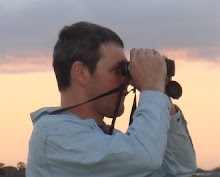
Blue-winged Warbler
Photo Credit: Arjuna Limitada
Autumn migration is in full swing. It is one of the best times of year to look for wood-warblers and other birds heading south for the winter. If you live in Centre County, Scotia Barrens (SGL 176) is among the best places to be.
Earlier this week, Woodcreeper was predicting a big migration event for Thursday and Friday. Recently, the weather conditions were not conducive for migrating birds. As a result, the birds were "piling-up", waiting for the right conditions to fly. Those condiditions were supposed to be right for a big flight on Wednesday and Thursday night. Unfortunately for me, I had to work. As such, I was unable to get out into the field to look for birds. As it turned out, most of the migrants ended up a bit the the east of central Pennsylvania.
I was hoping that the birds would continue in large numbers until at least the weekend. Excitedly, I headed out to Scotia Barrens early Saturday morning. It was a really slow day. Didn't see much at all. Sunday morning rolled around, and it was damp and drizzling. It didn't look very promising. I decided to go out anyway, as Monday would bring another work week.
As it turns out, it was a phenomenal day at Scotia! Easily the best day I have had in recent memory.

Whip-poor-will
Photo Credit: Mike Danzenbaker
I arrived at the research shed about 30 minutes before dawn. A few Whip-poor-wills and a Woodcock were active. I could also hear a migrating thrush overhead - mostly Swainson's Thrush. There were also others, but I didn't feel confident enough to ID them. I walked the paved road past the research shed just after sunrise. The trees around the field station were overloaded with warblers. There were easily a few hundred warblers present, as well as a nice sized flock of Waxwings. In addition, there were several Philadelphia Vireos as well.

Black-throated Green Warbler
Photo Credit: Lillian Stokes
After about 90 minutes, I returned to the main road. It started raining and the activity really slowed down. I ran into Greg Grove and we birded along the road, finding a Yellow-bellied Flycatcher. After the rain stopped, the birds picked up again. Wave after wave rolled thru. The area around the shed, as well as up and down the road about 100 yrds on each side had the most activity. Black-throated Green Warblers were seemingly everywhere. I stopped counting at 60 - there very easily could have been over 100 of that species alone. There were also large numbers of Blackburnian and Cape May Warblers.

Blackburnina Warbler
Photo Credit:
When I reluctantly left just before noon (to maintain marital bliss), the activity was still very high. In all, I observed 18 species of warbler. The full list follows:
Location: Scotia Barrens (IBA)
Observation date: 9/12/10
Number of species: 49
Ruffed Grouse 1
Turkey Vulture 1
Sharp-shinned Hawk 1
Red-tailed Hawk 1
American Woodcock 2
Great Horned Owl 1
Whip-poor-will 2
Red-bellied Woodpecker 1
Downy Woodpecker 1
Hairy Woodpecker 3
Northern Flicker 1
Pileated Woodpecker 2
Yellow-bellied Flycatcher 1
Least Flycatcher 1
Philadelphia Vireo 3
Red-eyed Vireo 8
Blue Jay 5
American Crow 7
Black-capped Chickadee 15
Tufted Titmouse 12
Red-breasted Nuthatch 1
White-breasted Nuthatch 4
Swainson's Thrush 20
American Robin 25
Gray Catbird 15
Cedar Waxwing 70
Blue-winged Warbler 3
Tennessee Warbler 4
Nashville Warbler 21
Northern Parula 4
Chestnut-sided Warbler 16
Magnolia Warbler 9
Cape May Warbler 25
Black-throated Blue Warbler 3
Black-throated Green Warbler 60
Blackburnian Warbler 22
Pine Warbler 11
Bay-breasted Warbler 3
Blackpoll Warbler 6
Black-and-white Warbler 6
American Redstart 7
Ovenbird 2
Common Yellowthroat 11
Hooded Warbler 3
Eastern Towhee 7
Scarlet Tanager 3
Northern Cardinal 1
Rose-breasted Grosbeak 2
American Goldfinch 1
This report was generated automatically by eBird v2(http://ebird.org)




